The Adelsverein Trilogy Walking Tour of Fredericksburg
It has been suggested by readers and fans, that I ought to outline some kind of walking tour of Fredericksburg, Texas – the location where much of the Adelsverein Trilogy took place. Because the story encompassed those founding and early days of Fredericksburg, the lives of real people, and because I had done so much research and because it is really quite a small place, and even smaller during those early years and I have a bug about visualizing places and rooms as they exist even if only in my imagination . . . I took some care in incorporating the fictional homes of the Steinmetz and Richter places into the existing fabric of Fredericksburg, and working out where they would have been, what streets they were on, where they were in relation to other landmarks, which direction the windows would have looked out to – and what my characters might have seen, looking out. Readers have asked me where exactly are these places are today, in relationship to Main Street and other easily identifiable landmarks. A few exist still, but not many in the same form as they did in the 1840s – and of them, which did I use to build my mental image of Fredericksburg? Herewith – some answers, all of them within a few blocks of Main Street – which would have been called San Saba Street, or Hauptstrasse in the early days.
Fredericksburg was laid out on a stretch of slightly higher land between two creeks: Baron’s Creek and Town Creek, a narrow town of three or four long streets roughly parallel to the creeks, and a number of cross streets. The center of town is still called the Marketplatz, or Market Square. The center of Market Square, which remained open for several decades, was dominated by the Vereinskirche, or Society Church.
The original Vereinskirche was slap in the middle of Main Street then – the present building is a reconstruction, and moved into it’s present location in the center of that half of Market Square to the north-east of Main Street. Other civic buildings – county courthouse, library, police department take up the half of the old Market Square to the south-west, between Adams and Crockett Streets.
There is an excellent and very detailed map available through the Fredericksburg Visitor Center, or at many local merchants on Main Street, or you might call up a map through electronic means: in any case, the tour begins at the corner of Main (290) and Washington (87). Very likely you would have come in to Fredericksburg on either of those routes.
#1 – The Nimitz Hotel is the most prominent landmark at that intersection: it began very humbly in the 1850s: an adobe house of four rooms, which an enterprising young clerk bought and made into a hotel. It was the center of social life all throughout the rest of the century.
“Where were you dreaming of building your hotel?” Magda asked.
“Main Street, of course; this is the place I was thinking of, on the corner. I look at it every day from the front of the commissary.” They had nearly reached the Verein compound, where Magazine Street intersected with Main, and the town-lots had been distributed to the first settlers.
“I’d buy this one first with the house on it, and the one next to it when I could afford it,” Charley looked thoughtful. Magda said, “It looks rather small, for a hotel.”
“Four rooms. I’d build on, of course. It’ll be a lot of work.” (From Book One – The Gathering)
Before C.H. Nimitz purchased that lot, with an existing building on it, the corner was the site of Mr. Ransleben’s store. Mr. Ransleben had opened the very first mercantile in Fredericksburg, but after his first wife ran away with a soldier from Fort Martin Scott, he sold his Fredericksburg property and moved to Comfort.
#2 – Catty-cornered from the Nimitz Hotel is a Subway Sandwich shop – the site of the original blockhouse, constructed by the surveyor’s party who first came to Fredericksburg at the direction of John Meusebach to plot out the streets. They cached some necessary tools nearby, burying them in the ground. The current owners of the land have found some traces of at least one pit and hope to have a proper archeological dig The first settlers to arrive in Fredericksburg camped at the blockhouse, upon their arrival from New Braunfels in 1846.
The sun had begun to sink low in the afternoon sky, that time where everything was touched with gold, when they forded a small creek and came at last into a vast grove of great oak trees. Bars of sunlight slid between the branches overhead, gilding the edges of the new green leaves, and scattering spots of themselves like golden coins in the leaf-mast at their feet in those places were there was not a thick undergrowth of brush. Huge tangles of wild grapevines festooned the lower branches, already hung with dusty green bunches of grapes.
In the very middle of this forest Mr. Bene and his advance party had made a place where those bushes had been cleared away. A half-built log blockhouse stood in a little space of trampled mud and wood-chips. Mr. Bene’s troopers were dismounting, the teams from the first wagons already unhitched
“We’re here!” Friedrich exclaimed, “Oh, Vati, it’s beautiful!”
“It’s a wilderness,” said Liesel bleakly, while Hansi looked first delighted and then puzzled, as he lifted her down from the cart. Vati beamed in frank delight.
“It is like the Black Forest! Such trees, my dears! Of such beams were the roofs of the cathedrals built … and does it not seem very like a cathedral? So hushed and dim! ” (From Book One – The Gathering)
If you turn right on Main Street and walk west for two blocks, you will come to the intersection of Lee and Main – and directly across from the T-intersection is a tiny frame church building, with a historical marker in front. This building dates from the 1880s, and was the church for a handful of black residents of Fredericksburg. According to local historian Kenn Knopp many free blacks came to Gillespie County before the Civil War to escape suspicion and harassment which otherwise would have made their lives miserable, if not dangerous. Before the church was built on the site, there was a small structure which served during the week as a school for the black children, and a church on Sunday. In Book Two – The Sowing, this was the site for the murder of the Itz brothers.
“…and she came up to the little chapel which was the church for the area’s handful of free Negroes, like the Phillipses, who lived in town and on the properties close by. A small crowd gathered in the street, a still somber crowd, most of them looking at something on the ground. A woman wept, with an edge of hysteria in her cries. Magda saw more people running from nearby houses and from farther up the street to join them.
“It was Duff’s men!” she heard the woman scream. With sudden apprehension cold in her heart, she came upon the shifting crowd, hugging Lottie to her breast and leading the cows closely by their halters. The two boys lay ungainly sprawled on the dusty ground, fallen slack in the way that she knew meant that they were dead. The younger boy lay half on his side, a bright red pool widening under his head, but Jacob lay with his eyes still half-opened, staring up towards the sky with expression of surprise on his face.
“Shot them down in the street, as if they were animals!” she heard a man say, in a wondering voice. “Before our eyes, as if they cared nothing about who saw them do it!”
#3 – About half a block down Washington Street, where it runs along the outbuildings of the Nimitz Museum, there is a gate in a tall wall, which leads into what was once a stable-yard, and the bath house for hotel gusts. A huge oak tree stands by that gate. The outlaw J.P. Waldrip was shot and fell dead under this tree in 1867. The identity of his assailant is still a mystery – and perhaps there was good reason for that, as well as an unspoken agreement among the good citizens of Fredericksburg.
Charley’s hotel and outbuildings lined one entire block, between Main and Austin Streets, facing a row of small homes and shops opposite. She held Lottie’s hand tightly, all thought of a leisurely stroll down Main Street forgotten with this news. She urgently wanted to speak to Charley, to Mr. Vining, to her son, to the Sheriff – anyone! J.P. Waldrip must not be allowed to escape. As she swept past the oak tree, her skirts rustling like a storm in a bed of reeds, she heard someone scream, and the dark figure of a man ran out of the stable-yard.
It was Charley’s daughter Bertha who screamed and screamed again as the man ran towards Magda and Lottie, “It’s him!”
Magda stood rooted to the spot; fear, shock and anger warring within her breast. Yes, her mind told her with chill precision; that was J.P. Waldrip, stumbling as his eyes darted here and there, like a trapped animal seeking escape, a fox hearing the hounds baying all around . . .
(From Book Three: The Harvesting)
#4 – The end of the block, where Washington intersects with Austin Street – presently the back end of the Japanese Peace Garden on the grounds of the Nimitz Museum – was in the 19th Century, the site of the stage stop. This was very conveniently located for travelers going west by stage, and wished to avail themselves of clean sheets, hot baths and good food – the best that would be available for at least a thousand miles.
Magda now sat with Anna beside her, Lottie on her lap on a bench at the back of the Nimitz Hotel, waiting for the mid-week stage to San Antonio, while Hannah played hop-scotch with herself on set of squares scratched in the dirt nearby. There were a handful of men also waiting the stage, but they respectfully tipped their hats to the women and stood a little apart. Magda did not know any of them – Americans, she supposed, as they spoke to one another in English. She cringed inwardly at the extravagant cost of such a journey, first to San Antonio, and thence to Victoria and Indianola, but Hansi had insisted that it was actually a sensible economy. (From Book Three: The Harvesting)
#5 – If you turn to the right, and follow Austin Street, a narrow bridge covers what remains of Town Creek. After two blocks, Austin Street makes a dog-leg turn to the left, and another block brings you to the old City Cemetery, established in 1846. “Vati” Steinmetz, Rosalie and Robert Hunter, little Christian Richter, and all the others – – many of the main characters in the Trilogy would have been buried there – that is, if they were real people.
She and Lottie picked armfuls of sweet wildflowers from the fields beyond Town Creek, and from the banks of the creek, to add to the little handful of new-blossoming daffodils from their own garden. They walked among the stones and monuments – so many of them there were now, so many friends! Dear Mrs. Helene, Pastor Altmueller’s wife, Liesel and Hansi’s son Christian, dead in the diphtheria epidemic in the last year of the war, and now Vati, dearest of all . . . (From Book Three – The Harvesting)
#6 – If you turn left and walk along Austin Street, or walk back from the City Cemetery, you will pass the entrance to the public parking, and the Fredericksburg Visitor’s Center. Many of the original settlers houses along Austin Street backed on Town Creek: Pastor Altmueller’s place was one that I visualized as being among them. This house on the far side of the entrance to the public parking lot is fachwork, and not a two-pen dog-trot cabin that I described – but it is about in the right place, with a garden in front and a creek in back.
Herr Pastor Altmueller and his wife, dear Mrs. Helene had drawn a town lot on Austin Street on the bank of Town Creek, a steep-banked rivulet which set the northern border of town. With the help of his friends and parishioners, he had built a sturdy, two-room cabin with an open breezeway between. Mrs. Helene had begun a flower garden, planting many flowering shrubs and trees around it, beds of bulbs which still came up every year and sturdy perennial herbs. Mrs. Helene, with her refined tastes would have seen to a bigger and more comfortable house, but she had died quite suddenly in a cholera epidemic which had swept through town fifteen years before and left her husband to settle into simple bachelor ease in his two simple rooms and porch. ‘The smaller it is, the less there is to clean’ he was often fond of pointing out to Vati. (From Book 2: The Sowing)
#7 – Walk back up Lincoln Street, past the Museum of the Pacific War, and turn to the right when you reach Main Street. Practically nothing on Main Street dates from before the Civil War – but this would have been the heart of town. Merchants and tradesmen included Mr. Specht, who opened one of the first stores and traded freely with the Indians for meat, honey and pecans, in the very earliest days. Mr. Kiehne the blacksmith had his smithy established under a huge oak tree on Main Street, where he later built the first two-story house in town. According to notes from a local historian this is at 405 East Main, just to the west of the Auslander Restaurant. Mr. Muller the druggist and postmaster had his establishment a few blocks farther east, at or near 120 East Main. In The Sowing, this is where there was a crowd reading the latest newspaper posted on the window, and where Schoolmaster Scheutze was overheard by two of J.P. Waldrip’s men, making a joke at the expense of the Confederacy.
John Hunter, the young American who came to town and married a German girl, Sophie Ahrens – his store was also there, at the corner of Main and Adams – which in the early days was called Market Street.
“They’ve burnt my store,” John Hunter said as he nudged his horse forwards. Standing still by the overlooking window, Magda gasped: John Hunter’s store was on the corner of Main and Market Street, a short way from her father’s house and workshop in Friedrichsburg. Before her marriage, she walked past it often; a long log house with many additions at the back, for John Hunter did much business with friendly Indians, and the soldiers at the fort, as well as the German settlers in the district. (From Book Two: The Sowing)
#8 – Walking a north on Adams, and past the Beckendorf Gallery, you will come to a long, narrow building, which housed the Arlhelger’s workshop. The Arlhelger family arrived with the first wagon-train; William Arhelger took up the trade of carpentry, furniture-building – and when it was required, coffin-building. Magda comes here, during the diphtheria epidemic in the last year of the Civil War, to ask him to build a coffin for Liesel and Hansi Richter’s young son.
He greeted Magda cheerily enough, but his face fell into unaccustomedly solemn lines when she told him of Liesel’s need.
“Sorry to hear that, Mrs. Magda, so sorry indeed! No, put away that gold piece. No need for that among old friends. Just tell Hansi to bring me some nice bits of brass and that for fittings or something, the next time he comes this way. Better yet, tell him to call on me so I can tell him the kind of thing to keep his eye open for.” (From Book Two: The Sowing)
#9 – Turn around and walk south, back towards Main Street, and continue another block, past the Gillespie County Courthouse, until you reach the intersection of Adams and San Antonio Street: there is a church parish hall and a small parking lot on that corner – but this is where I sited Vati Steinmetz’s house; the fachwork house with a shop premise and a garden in back.
The house that his guide pointed out was indeed half-built: a skeleton of square beams, braces and window frames delineating where the future walls would be. It sat close to the street, like some of the houses in the older Mexican parts of Bexar. The far half was finished, the space between beams filled in and plastered over. Shutters covered the window openings, and a drift of smoke rose lazily from a chimney; it looked as though they had finished half of it far enough to move in. Carl walked towards the unfinished corner, drawn by the sound of happy voices, children laughing, and a chorus of men’s voices, raised in song. He could walk through the framework of beams, towards the yard in back of the house, where two huge post-oaks shaded what might be a pleasant and sheltered garden someday. (From Book One: The Gathering)
From this corner, looking west along San Antonio Street at the back of the Gillespie County Courthouse, you can see a square, two-story limestone block of a building with heavily barred windows – the old jail. This building was not the original jail building, but the jail which existed during the Civil War was likely very close to this site, as all the civic buildings were – and still are clustered around the Marketplatz. The Civil War era building was the one from which a number of detained draft evaders escaped in the last months of the war.
… Late one night there was a tumult of shouting and the sound of horses’ hoofs, a rattle of muffled shots. Magda and Anna barricaded the doors and stayed huddled inside until dawn. They did not dare open them until then, when Charley Nimitz came and pounded on the front door.
“Just so you know, there’s been a jailbreak,” he said cheerfully.
“Not that dreadful Banta fellow and his men,” Vati asked, with incredulous disgust, “They should be torn to pieces by angry women for what they did to the Itz boys and others!”
Charley shook his head, seeming almost smug. “No, they’re still prisoners, and damn lucky to be in the jail and not the burying ground. A mob of masked men burst into the jail last night and overpowered the guards.” Charley’s face was innocently, carefully bland. “They shot into the cells where Banta and his chaps were being held, but that wasn’t their purpose, or so I was told.”
“And that was?” Magda looked very carefully at Charley, as neat and carefully turned out as a good bourgeoisie man of business always was. But she thought that she could see a faint dark shadow of soot at his hairline, and his boots were dusty.
“There were twenty-two men of the county, evaders and deserters, being held until they could be sent to San Antonio for trial,” Charley answered, his eyes widening in seeming innocence. “They were to leave in a day or so, when the provost sent a proper escort for them.” Charley spread his hands. “But now they are all gone, cleared out lickety split with all their weapons and possessions, horses also. Imagine the chagrin on the faces of the military provost!”
“Imagine,” Magda answered dryly. “They will have made a long journey for nothing,”
“Not at all,” Charley answered. “They will remove Banta and his men to the jail in Burnet to await trial. For their safety,” he added, with deliberate irony. “So piquant an irony, Mrs. Magda. Having incited the mob, now they have a mob turned against them!”
“I doubt such barbarians as those can fully appreciate it,” Vati said, with much heat. The cruel end of Schoolmaster Schuetze still weighed very much upon him. “What of that beast Quantrill and Waldrip and those others of his band? Are they also arrested for their crimes?”
“They were,” Charley sighed, “they were … but they escaped. I have it on good authority that Colonel McCulloch was much put out. He is a man of honor, though I fear you will find that hard to believe. He little liked such allies as they were. Waldrip has fled to Mexico, Quantrill and his ilk back to Kansas with a good peppering of Texas lead to speed their departure.”
“Indeed,” Magda said dryly. For an officer of a ranging company, Charley seemed indecently pleased at the evidence of lawlessness and disorder presented by the abrupt and officially unauthorized departure of twenty-two men from the jail. She hoped that he could hide that pleasure sufficiently from his superiors … From Book Two – The Sowing
#10 – Continue walking along Adams, past the Peach Tree Gallery and Tea Room, to Creek Street: Creek Street was called so, because many of the half-acre town-lots first surveyed and allotted to settlers backed on Baron’s Creek, which marked the boundary of town. Those lots were particularly prized for the rich soil and easy access to water. Hansi Richter drew a town-lot there, and built a tiny cottage, a Sunday House for his family to stay in, when they visited town. Carl and Magda spent their wedding night in this Sunday House, Anna and Marie Richter took the infant Grete and Lottie there, to prevent them being exposed, during the diphtheria epidemic. And the young bachelors; Peter Vining, Dolph Becker, Fredi Steinmetz, George and Jacob Richter all lived there, when Hansi was expanding his freighting interests after the Civil War. Turn right on Creek Street, and walk approximately a block and a half, to 201 West Creek: this is a tiny historic house, plaster over stone, with a metal roof. It was built fairly early on, for Pastor Dangers, who served for decades as the Lutheran minister. I described Hansi’s Sunday House as being built of sawn lumber, but in appearance and location, Pastor Danger’s house is a close fit.
There were lights behind the curtains of Hansi’s Sunday house, a tiny one-room cottage on the front of his town-lot. The hut where he and Liesel had first lived served as a stable now. Three horses moved restlessly in the corral next to it, and the light farm wagon which Carl had driven from his place was parked close by. All of the things that had been thought appropriate for a new wife to take to her husband’s roof were packed in it. In the morning, they would hitch up the team and go home, over the hills to that place which she had never seen and begin that new part of her life, joined to his life. But between now and then was tonight. (From Book One: The Gathering)
#11 – Continue walking on Creek Street, until you come to the intersection of Creek and South Orange. Turn right and walk back towards Main Street: at the corner of San Antonio Street and South Orange will be two church buildings, side by side. The older and plainer of the two is Old St. Mary’s or the Marienkirche, which was finished during the Civil War. It’s a kind of generic Gothic style church, spare and plain – no one knows who the architect who actually designed it was. It may be that the stone-masons just set to work, as a kind of committee. When Magda spent the summer of 1860 in Fredericksburg, suffering through a difficult pregnancy, she could hear them building the Marienkirche from Vati’s house.
She lay in bed and watched through the windows, at wagons full of stone passing by, to where the Catholic congregation was building a fine stone sanctuary with a tall tower in the next block, on San Antonio Street. In the mornings, she could hear the workmen calling to each other, and the ringing sound of hammers on stone. She thought that Vati might be able to see the steeple from his bedroom window – oh, dear, how that would annoy him! He still insisted that he was a freethinker, although he had always attended services with them, and the children. (From Book Two: The Sowing)
Continue walking towards Main Street; upon reaching it, turn left: The Pioneer Museum is in the next block. Many of the objects on display there gave me an excellent idea of what the various possessions of the early settlers looked like, and what they would have had in their kitchens and parlors.
(Other key locations will be added to this article, as I work out exactly where they were, as well as significant locations not within an easy walk. If you are certain about any locations mentioned in the Trilogy which can be added, let me know through email. at clyahayes-At-Gee-Mail- dot-com. Enjoy!)


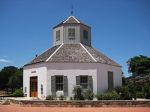
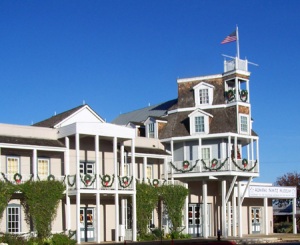

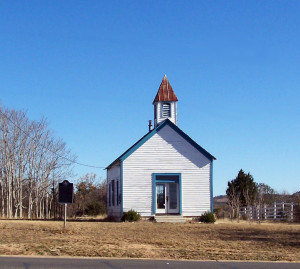
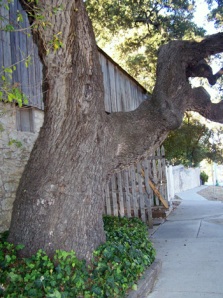

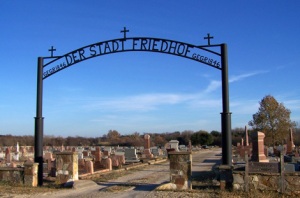
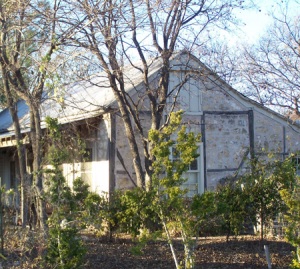
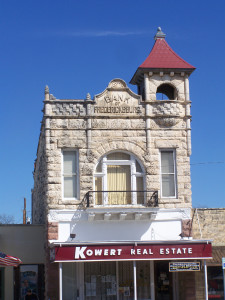
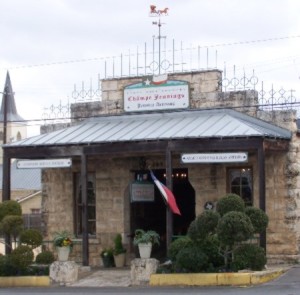
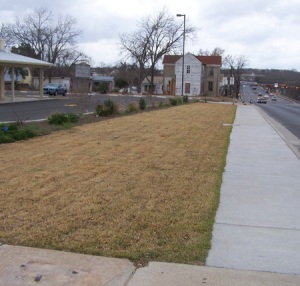
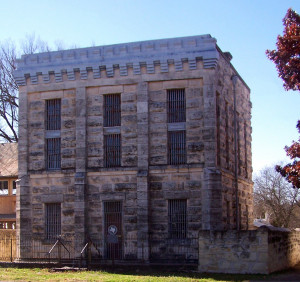
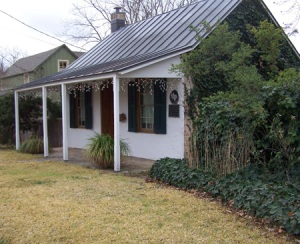
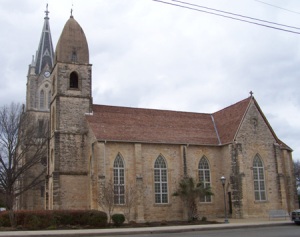
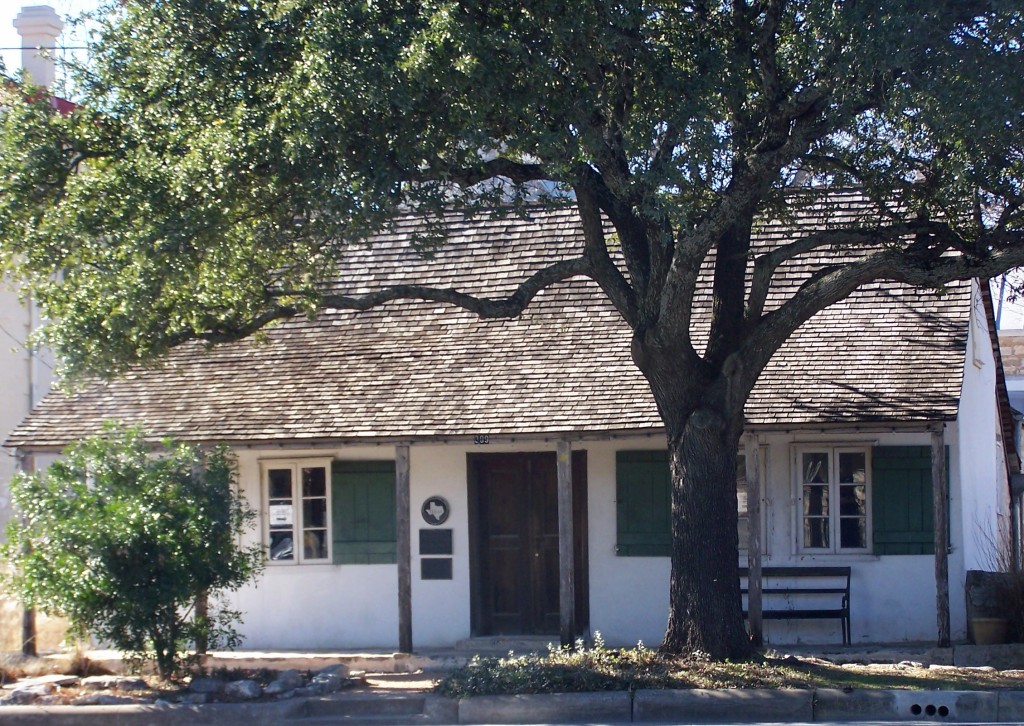
What a wonderful start to locating many of the places mentioned in the Trilogy. My friends in the FBG Book Club, Judi Synek, Kelly Albrecht, and Joannie Wyatt, are discussing ways to make your trip to our Book Club Oct. 13 a memorable one. Alas, I am not able to be in FBG until mid September because of family responsibilities in MN but will keep up by email. Evie